Microstructure and Corrosion Resistance of Quartz Sand-Modified Enamel-Coated Steel Plates
Abstract
:1. Introduction
2. Materials and Methods
2.1. Preparation of Quartz Sand-Modified Enamel-Coated Steel Plates
2.2. Microstructure, Phase Composition, and Surface Roughness of PE and QSME Coatings
2.3. Electrochemical Corrosion Tests
3. Results and Discussion
3.1. Phase Composition, Microstructure, and Surface Roughness
3.2. Electrochemical Test Results
3.2.1. Open Circuit Potential (OCP)
3.2.2. Electrochemical Impedance Spectroscopy
3.2.3. Potentiodynamic Polarization
4. Conclusions
- (1)
- When applied to structural steel plate, pure enamel coating has a relatively uniform thickness of around 104 µm. The quartz sands are completely embedded in the enamel coating matrix, and the coating thickness of QSME varies from 430 µm to 1424 µm depending on the size of the quartz sand;
- (2)
- Both PE and QSME coatings dramatically improve the corrosion protection of steel plates. The corrosion protection of QSME coating is comparable to that of PE coating and is ~1000 times greater than that of uncoated plates;
- (3)
- The corrosion resistance of QSME-coated plates reduces with an increase in the content of quartz sand, while the effect of the size of quartz sand is insignificant;
- (4)
- The QSME coating can be used to prolong the service lives of civil infrastructures subjected to chloride attack.
Author Contributions
Funding
Institutional Review Board Statement
Informed Consent Statement
Data Availability Statement
Conflicts of Interest
References
- Sagues, A.A.; Lau, K.; Powers, R.G.; Kessler, R.J. Corrosion of epoxy-coated rebar in marine bridges-Part 1: A 30-year perspective. Corrosion 2010, 66, 065001. [Google Scholar] [CrossRef]
- Andrade, C. Steel corrosion rates in concrete in contact to sea water. Cem. Concr. Res. 2023, 165, 107085. [Google Scholar] [CrossRef]
- Liu, J.; Zhang, W.; Li, Z.; Jin, H.; Tang, L. Influence of deicing salt on the surface properties of concrete specimens after 20 years. Constr. Build. Mater. 2021, 295, 123643. [Google Scholar] [CrossRef]
- Pedrosa, F.; Andrade, C. Corrosion induced cracking: Effect of different corrosion rates on crack width evolution. Constr. Build. Mater. 2017, 133, 525–533. [Google Scholar] [CrossRef]
- Yu, X.; Qian, K.; Lu, D.; Li, B. Progressive collapse behavior of aging reinforced concrete structures considering corrosion effects. ASCE J. Perform. Constr. Facil. 2017, 31, 04017009. [Google Scholar] [CrossRef]
- NACE International. International Measures of Prevention, Application, and Economics of Corrosion Technologies Study; NACE International: Houston, TX, USA, 2012. [Google Scholar]
- Heniegal, A.M.; Amin, M.; Youssef, H. Effect of silica fume and steel slag coarse aggregate on the corrosion resistance of steel bars. Constr. Build. Mater. 2017, 155, 846–851. [Google Scholar] [CrossRef]
- Saraswathy, V.; Song, H.W. Electrochemical studies on the corrosion performance of steel embedded in activated fly ash blended concrete. Electrochim. Acta 2006, 51, 4601–4611. [Google Scholar] [CrossRef]
- Valcuende, M.; Lliso-Ferrando, J.R.; Ramón-Zamora, J.E.; Soto, J. Corrosion resistance of ultra-high performance fibre- reinforced concrete. Constr. Build. Mater. 2021, 306, 124914. [Google Scholar] [CrossRef]
- Wang, D.; Han, L.; Kang, M.; Wan, M.; Ju, Y. Influence of corrosion on the bond performance of reinforcements and basalt fibre high strength concrete. Case Stud. Constr. Mater. 2022, 17, e01394. [Google Scholar] [CrossRef]
- Cui, L.; Hang, M.; Huang, H.; Gao, X. Experimental study on multi-component corrosion inhibitor for steel bar in chloride environment. Constr. Build. Mater. 2021, 313, 125533. [Google Scholar] [CrossRef]
- Liu, Q.; Song, Z.; Han, H.; Donkor, S.; Jiang, L.; Wang, W.; Chu, H. A novel green reinforcement corrosion inhibitor extracted from waste Platanus acerifolia leaves. Constr. Build. Mater. 2020, 260, 119695. [Google Scholar] [CrossRef]
- Song, Z.; Liu, Y.; Jiang, L.; Pei, C.; Xu, N.; Chu, H.; Guo, M. Using ultrasonic wave to trigger microcapsule inhibitor against chloride-induced corrosion of carbon steel in simulated concrete pore solution. Constr. Build. Mater. 2021, 311, 125331. [Google Scholar] [CrossRef]
- Li, S.; Zhang, L.; Wang, Y.; Hu, P.; Jiang, N.; Guo, P.; Wang, X.; Feng, H. Effect of cathodic protection current density on corrosion rate of high-strength steel wires for stay cable in simulated dynamic marine atmospheric rainwater. Structures 2021, 29, 1655–1670. [Google Scholar] [CrossRef]
- Dai, M.; Liu, J.; Huang, F.; Zhang, Y.; Cheng, Y.F. Effect of cathodic protection potential fluctuations on pitting corrosion of X100 pipeline steel in acidic soil environment. Corros. Sci. 2018, 143, 428–437. [Google Scholar] [CrossRef]
- Wang, B.; Lu, K.; Han, C.; Wu, Q. Study on anti-corrosion performance of silica fume modified magnesium potassium phosphate cement-based coating on steel. Case Stud. Constr. Mater. 2022, 17, e01467. [Google Scholar] [CrossRef]
- Yang, N.; Das, C.S.; Xue, X.; Li, W.; Dai, J.G. Geopolymer coating modified with reduced graphene oxide for improving steel corrosion resistance. Constr. Build. Mater. 2022, 342, 127942. [Google Scholar] [CrossRef]
- Thirumoolan, D.; Sakthinathan, S.P.; Siva, T. Corrosion protection properties of poly((benzoyl phenyl) methacrylate-co-methoxy ethylmethacrylate) coating on mild steel. J. Mol. Struct. 2022, 1264, 133186. [Google Scholar] [CrossRef]
- Zhong, X.; Liang, R.; Liu, G.; Pan, W. Zinc coating on steel by atmosphere plasma spray and their anti-corrosion behavior. Mater. Lett. 2022, 314, 131825. [Google Scholar] [CrossRef]
- Safavi, M.S.; Fathi, M.; Ahadzadeh, I. Feasible strategies for promoting the mechano-corrosion performance of Ni-Co based coatings: Which one is better? Surf. Coat. Technol. 2021, 420, 127337. [Google Scholar] [CrossRef]
- Sharma, N.; Sharma, S.; Sharma, S.K.; Mahajan, R.L.; Mehta, R. Evaluation of corrosion inhibition capability of graphene modified epoxy coatings on reinforcing bars in concrete. Constr. Build. Mater. 2022, 322, 126495. [Google Scholar] [CrossRef]
- Pour-Ali, S.; Dehghanian, C.; Kosari, A. Corrosion protection of the reinforcing steels in chloride-laden concrete environment through epoxy/polyaniline-camphorsulfonate nanocomposite coating. Corros. Sci. 2015, 90, 239–247. [Google Scholar] [CrossRef]
- Saravanan, K.; Sathiyanarayanan, S.; Muralidharan, S.; Azim, S.S.; Venkatachari, G. Performance evaluation of polyaniline pigmented epoxy coating for corrosion protection of steel in concrete environment. Prog. Org. Coat. 2007, 59, 160–167. [Google Scholar] [CrossRef]
- Figueira, R.B.; Silva, E.C.J.R.; Pereira, V. Hot-dip galvanized steel dip-coated with ureasilicate hybrid in simulated concrete pore solution: Assessment of coating morphology and corrosion protection efficiency. Prog. Org. Coat. 2015, 88, 245–255. [Google Scholar] [CrossRef]
- Al-Negheimish, A.; Hussain, R.R.; Alhozaimy, A.; Singh, D.D.N. Corrosion performance of hot-dip galvanized zinc-aluminum coated steel rebars in comparison to the conventional pure zinc coated rebars in concrete environment. Constr. Build. Mater. 2021, 274, 121921. [Google Scholar] [CrossRef]
- El-Hawary, M.M. Evaluation of bond strength of epoxy-coated bars in concrete exposed to marine environment. Constr. Build. Mater. 1999, 13, 357–362. [Google Scholar] [CrossRef]
- Tang, F.; Chen, G.; Brow, R.K. Chloride-induced corrosion mechanism and rate of enamel- and epoxy-coated deformed steel bars embedded in mortar. Cem. Concr. Res. 2016, 82, 58–73. [Google Scholar] [CrossRef]
- Pokorný, P.; Tej, P.; Kouřil, M. Evaluation of the impact of corrosion of hot-dip galvanized reinforcement on bond strength with concrete—A review. Constr. Build. Mater. 2017, 132, 271–289. [Google Scholar] [CrossRef]
- Rossi, S.; Russo, F.; Calovi, M. Durability of vitreous enamel coatings and their resistance to abrasion, chemicals, and corrosion: A review. J. Coat. Technol. Res. 2020, 18, 39–52. [Google Scholar] [CrossRef]
- Tao, J.; Guo, X.; Huang, Z.; Liu, H.; Wang, T. Preparation and characterization of enamel coating on pure titanium as a hydrogen penetration barrier. Nucl. Eng. Des. 2013, 259, 65–70. [Google Scholar] [CrossRef]
- Fan, L.; Tang, F.; Reis, S.T.; Chen, G.; Koenigstein, M.L. Corrosion resistance of steel pipes internally coated with enamel. Corrosion 2017, 73, 1335–1345. [Google Scholar] [CrossRef]
- Rossi, S.; Zanella, C.; Sommerhuber, R. Influence of mill additives on vitreous enamel properties. Mater. Des. 2014, 55, 880–887. [Google Scholar] [CrossRef]
- Samiee, L.; Sarpoolaky, H.; Mirhabibi, A. Microstructure and adherence of cobalt containing and cobalt free enamels to low carbon steel. Mater. Sci. Eng. A 2007, 458, 88–95. [Google Scholar] [CrossRef]
- Wang, D. Effect of crystallization on the property of hard enamel coating on steel substrate. Appl. Surf. Sci. 2009, 255, 4640–4645. [Google Scholar] [CrossRef]
- Rossi, S.; Russo, F.; Gasparre, N.; Fontanari, V. Influence of graphene addition on the mechanical and surface properties of vitreous enamel coatings. Surf. Coat. Technol. 2020, 398, 126071. [Google Scholar] [CrossRef]
- Qian, H.; Chen, S.; Wang, T.; Cheng, G.; Chen, X.; Xu, Z.; Zeng, Q.; Liu, Y.; Yan, D. Silicon nitride modified enamel coatings enable high thermal shock and corrosion resistances for steel protection. Surf. Coatings Technol. 2021, 421, 127474. [Google Scholar] [CrossRef]
- Tang, F. Enamel Coated Steel Reinforcement for Improved Durability and Life-Cycle Performance of Concrete Structures: Microstructure, Corrosion and Deterioration. Ph.D. Thesis, Missouri University of Science and Technology, Rolla, MO, USA, 2013. [Google Scholar]
- Jamil, H.E.; Shriri, A.; Boulif, R.; Montemor, M.F.; Ferreira, M.G.S. Corrosion behaviour of reinforcing steel exposed to an amino alcohol based corrosion inhibitor. Cem. Concr. Compos. 2005, 27, 671–678. [Google Scholar] [CrossRef]
- Rodíguez Presa, M.J.; Tucceri, R.I.; Florit, M.I.; Posadas, D. Constant phase element behavior in the poly(o-toluidine) impedance response. J. Electroanal. Chem. 2001, 502, 82–90. [Google Scholar] [CrossRef]
- Hirschorn, B.; Orazem, M.E.; Tribollet, B.; Vivier, V.; Frateur, I.; Musiani, M. Determination of effective capacitance and film thickness from constant-phase-element parameters. Electrochim Acta. 2010, 55, 6218–6227. [Google Scholar] [CrossRef]
- Zhang, Y.; Shao, Y.; Zhang, T.; Meng, G.; Wang, F. The effect of epoxy coating containing emeraldine base and hydrofluoric acid doped polyaniline on the corrosion protection of AZ91D magnesium alloy. Corros. Sci. 2011, 53, 3747–3755. [Google Scholar] [CrossRef]
- Hassan, H.H.; Abdelghani, E.; Amin, M.A. Inhibition of mild steel corrosion in hydrochloric acid solution by triazole derivatives. Part I. Polarization and EIS studies. Electrochim. Acta. 2007, 52, 6359–6366. [Google Scholar] [CrossRef]
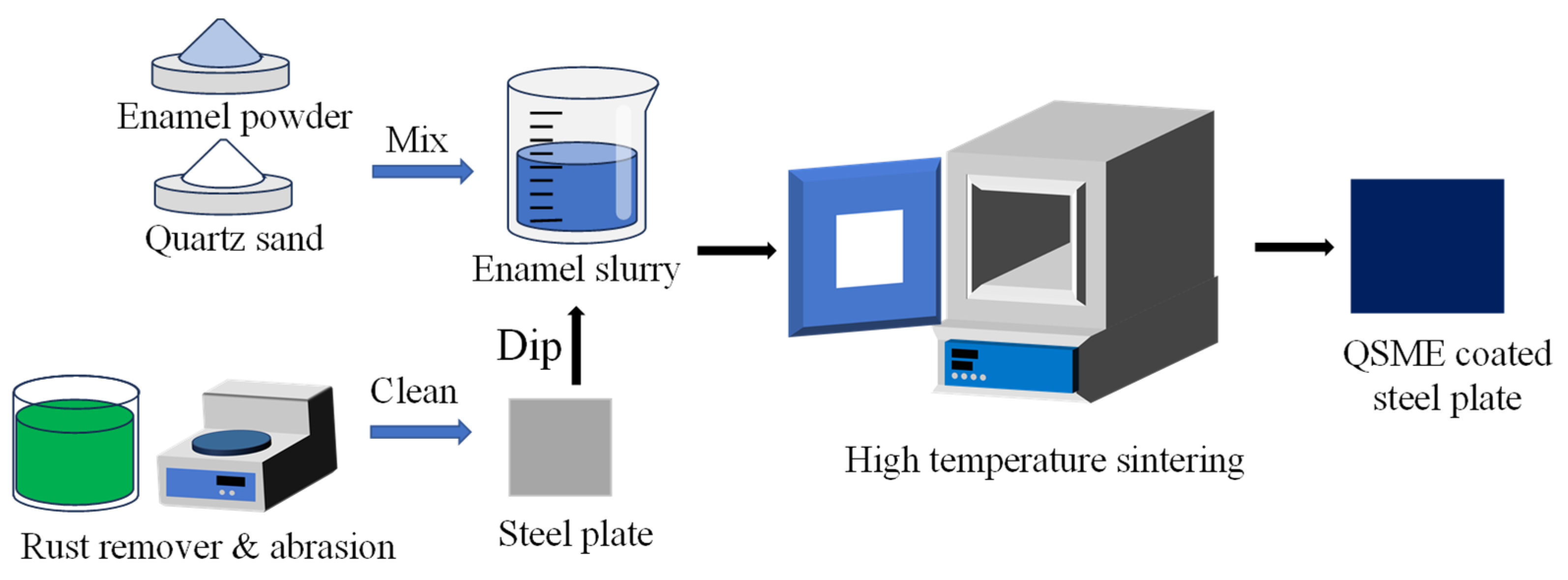
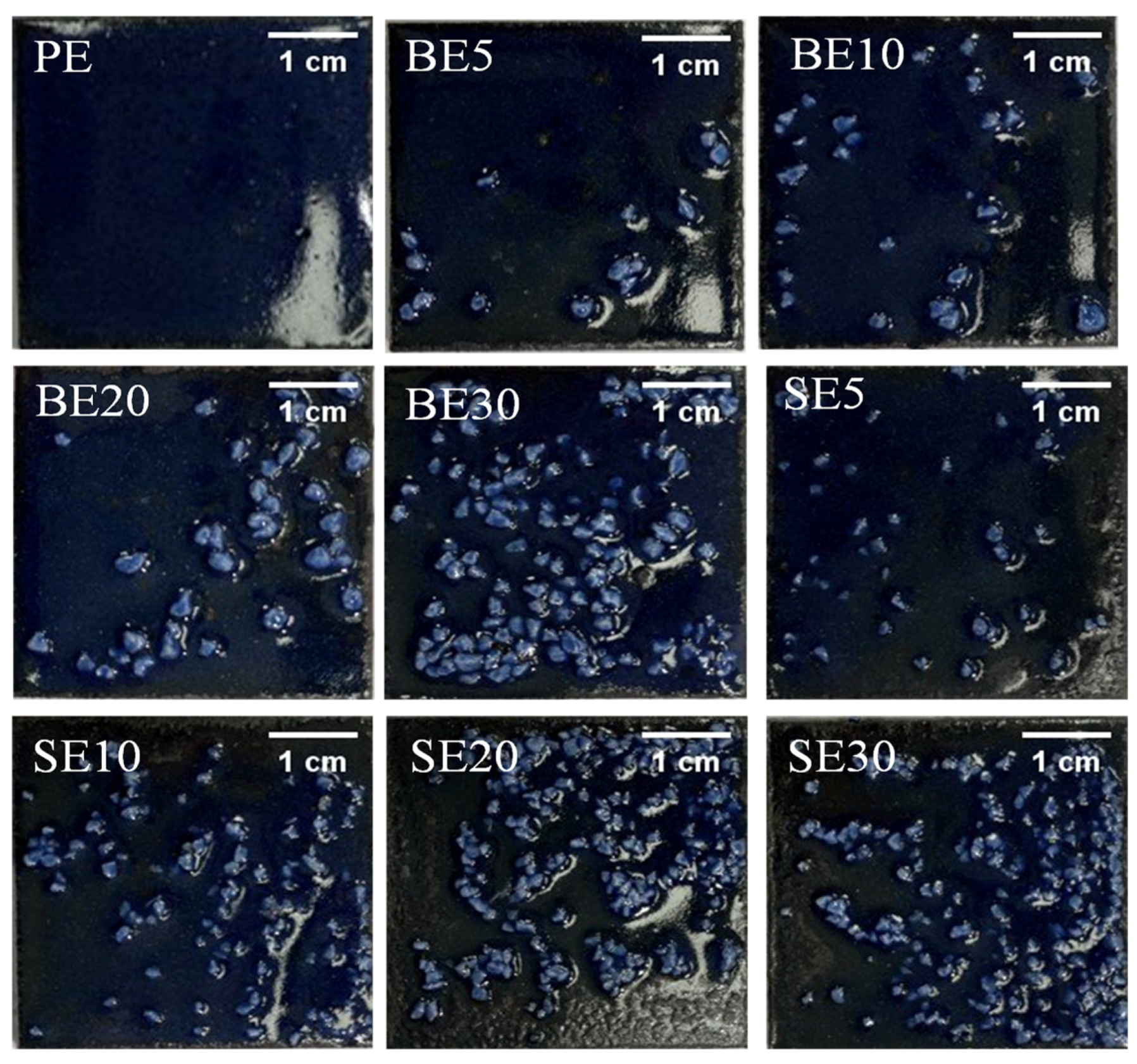

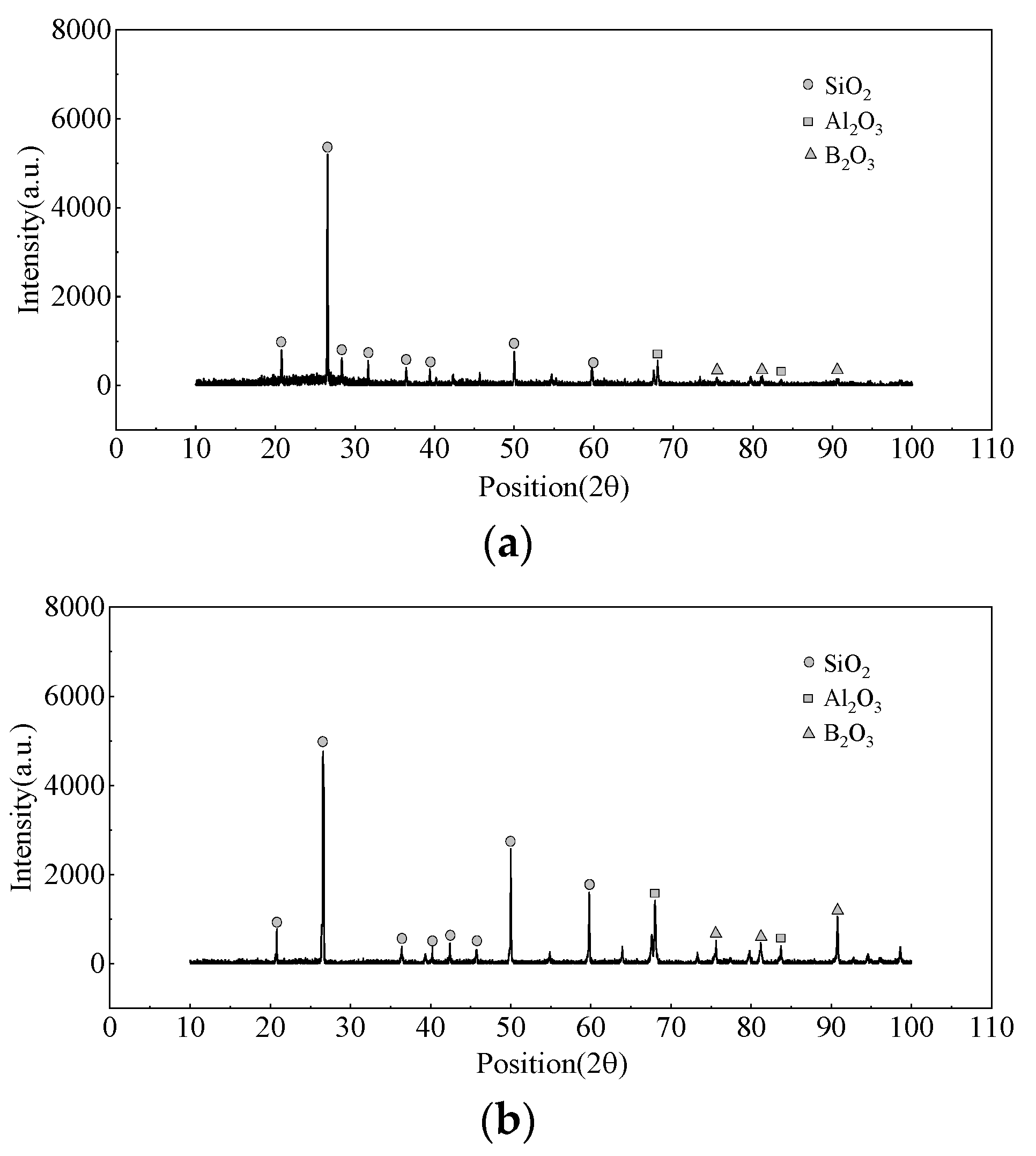
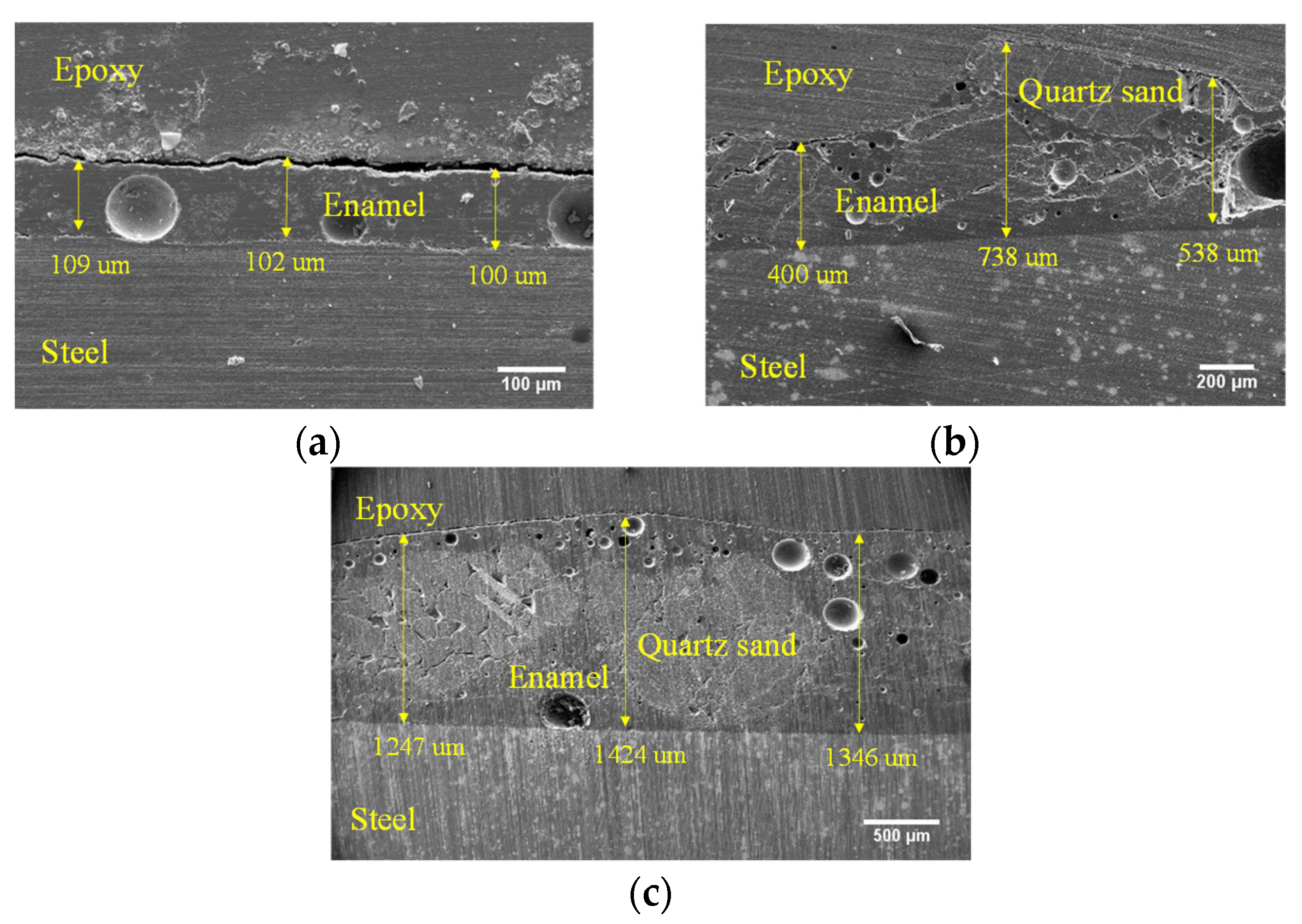
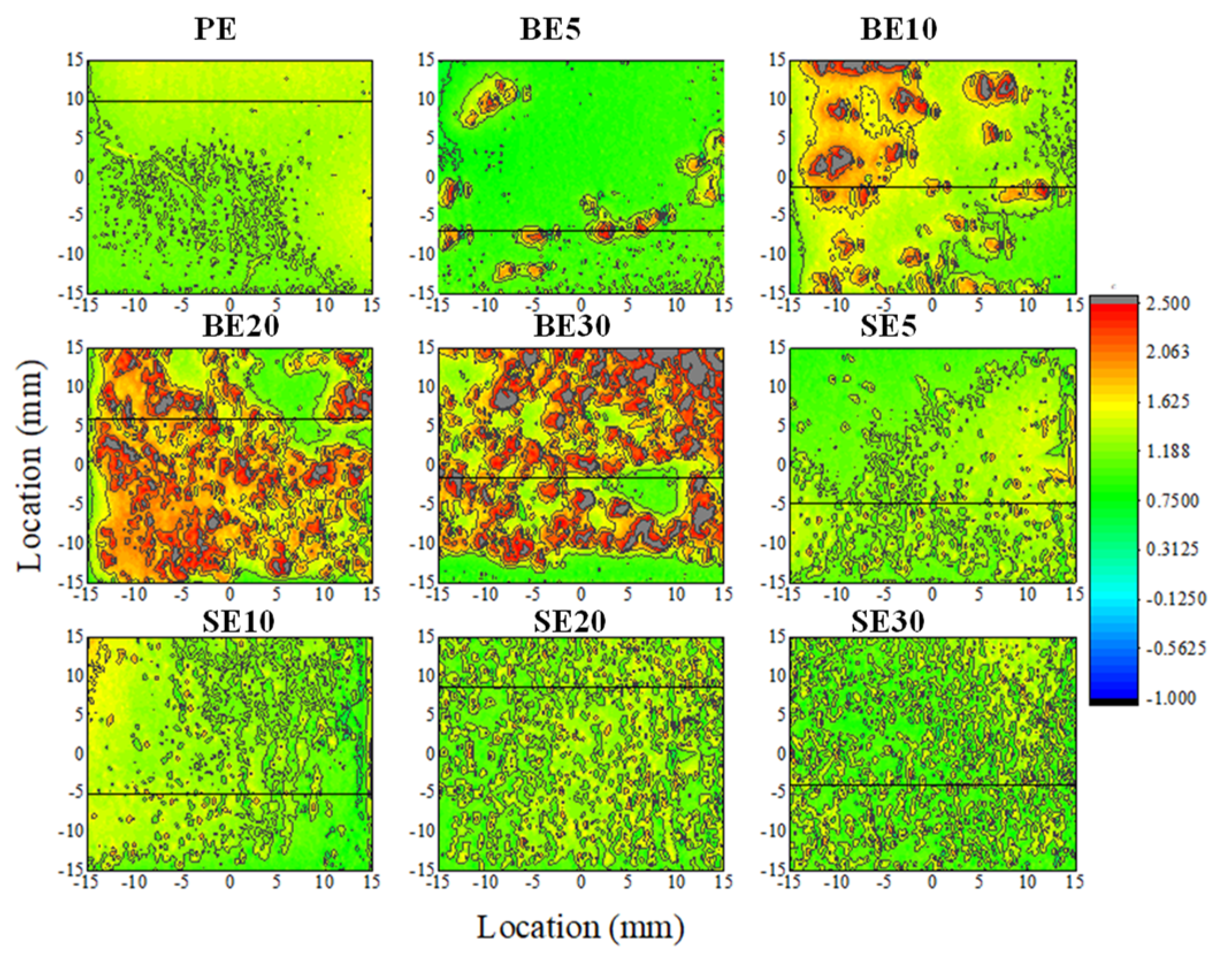

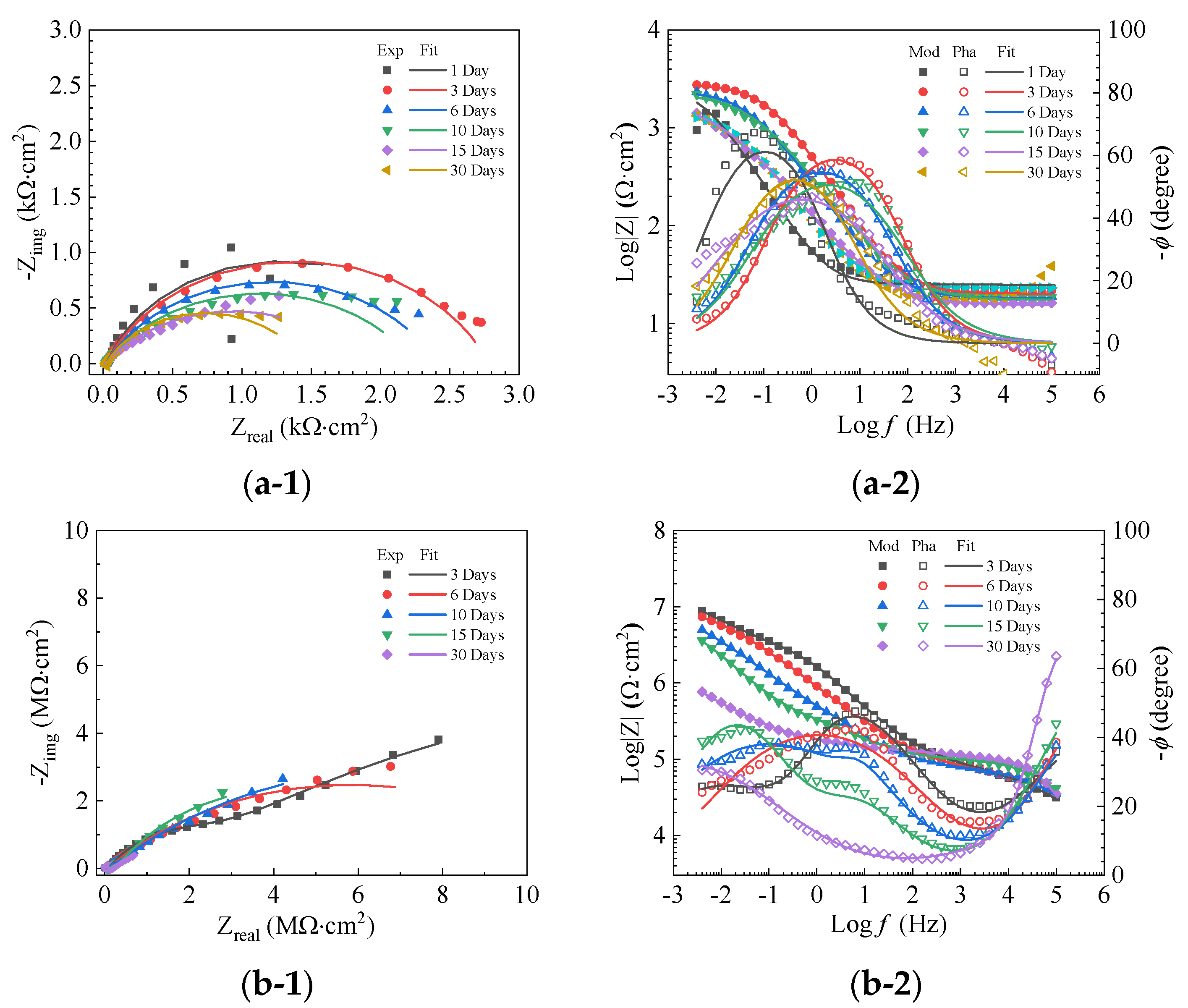

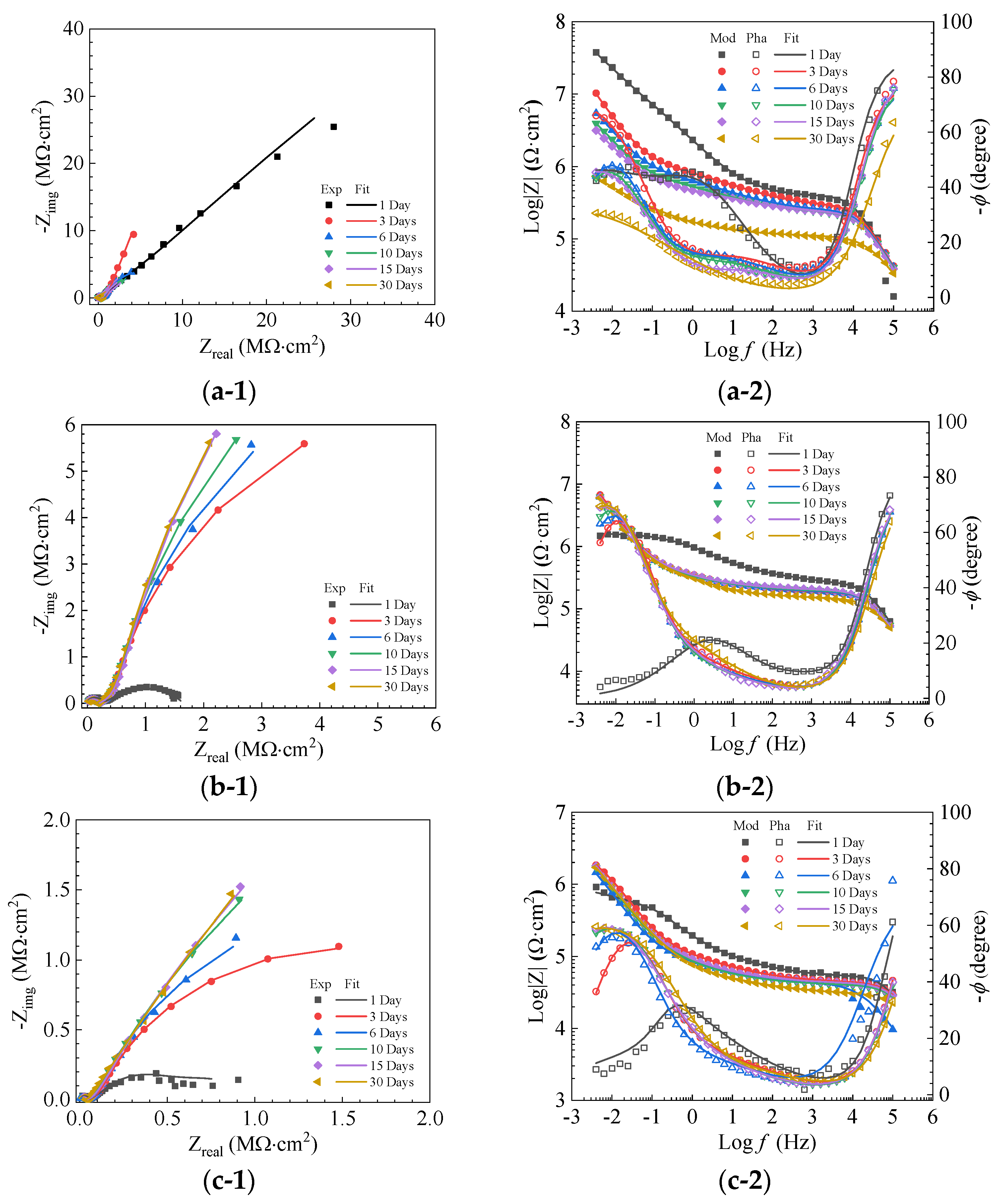
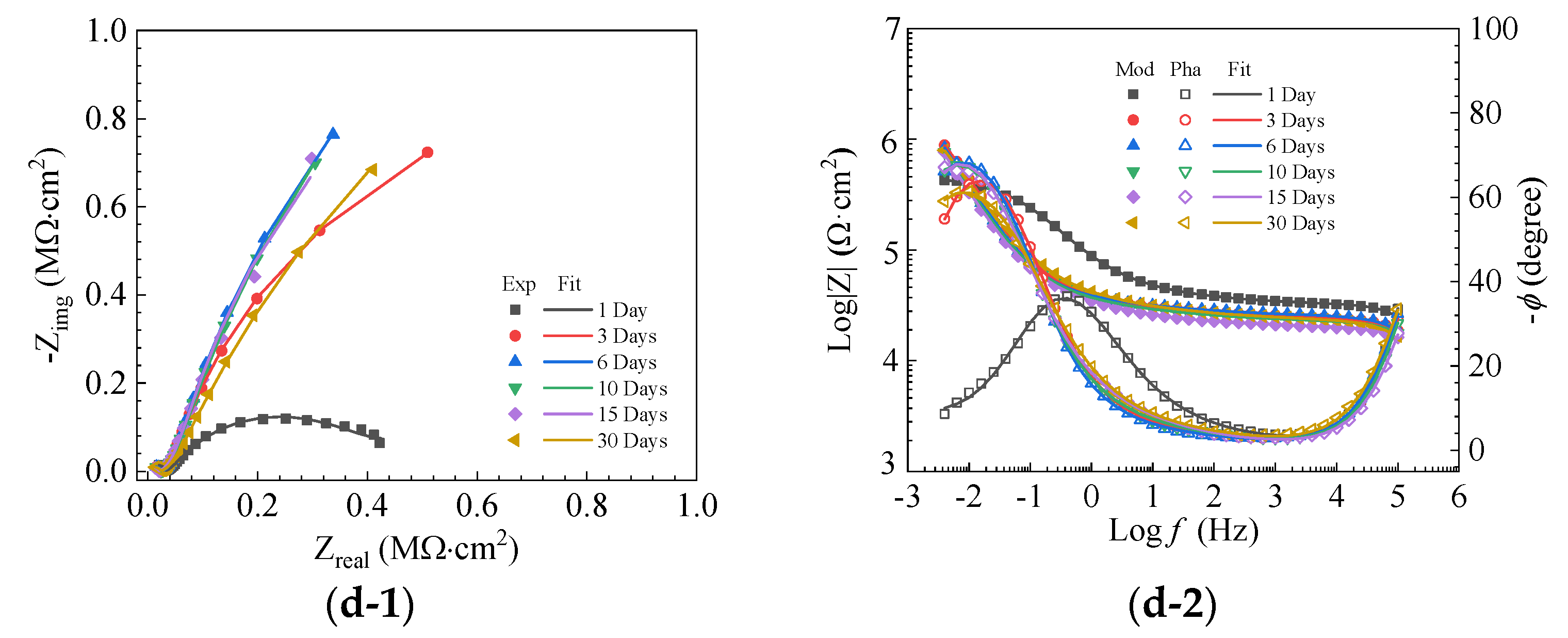
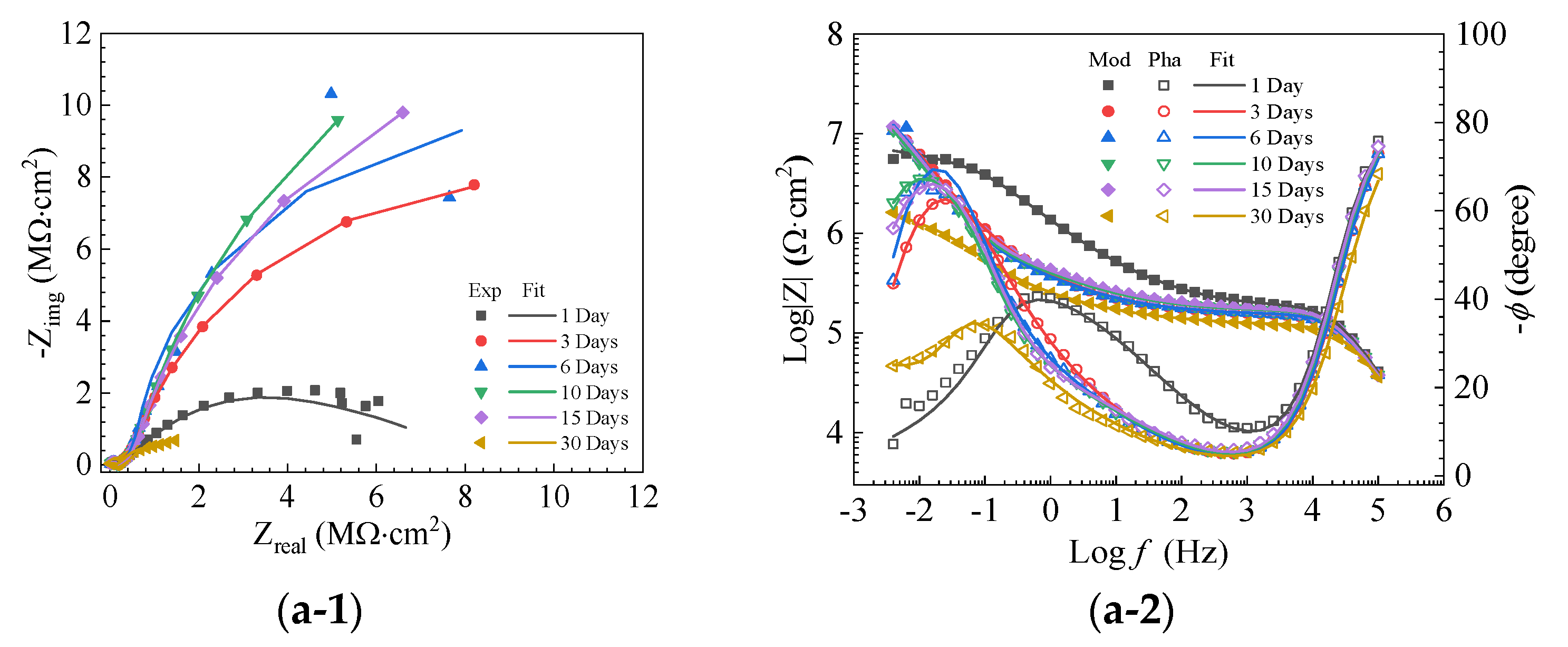
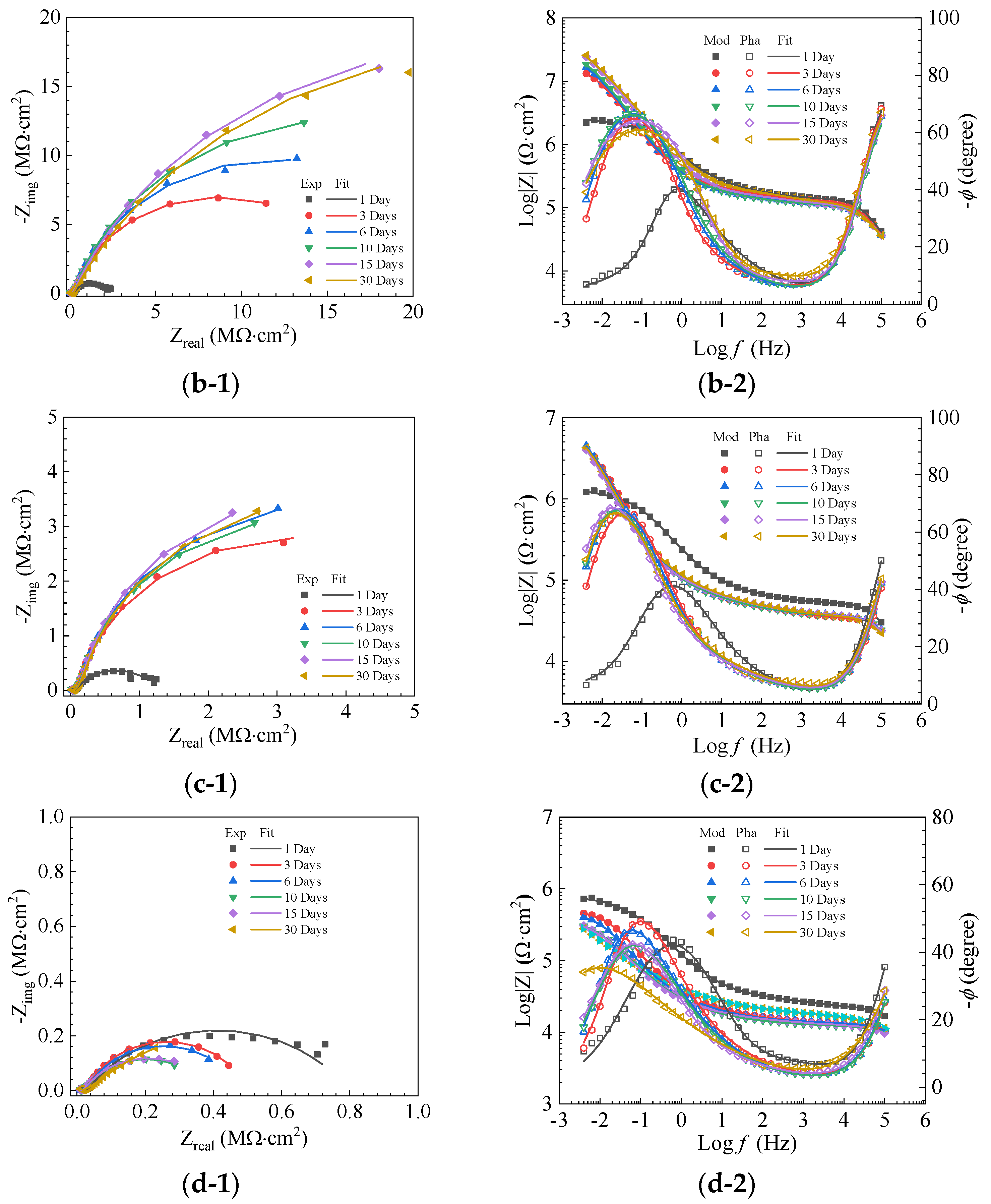
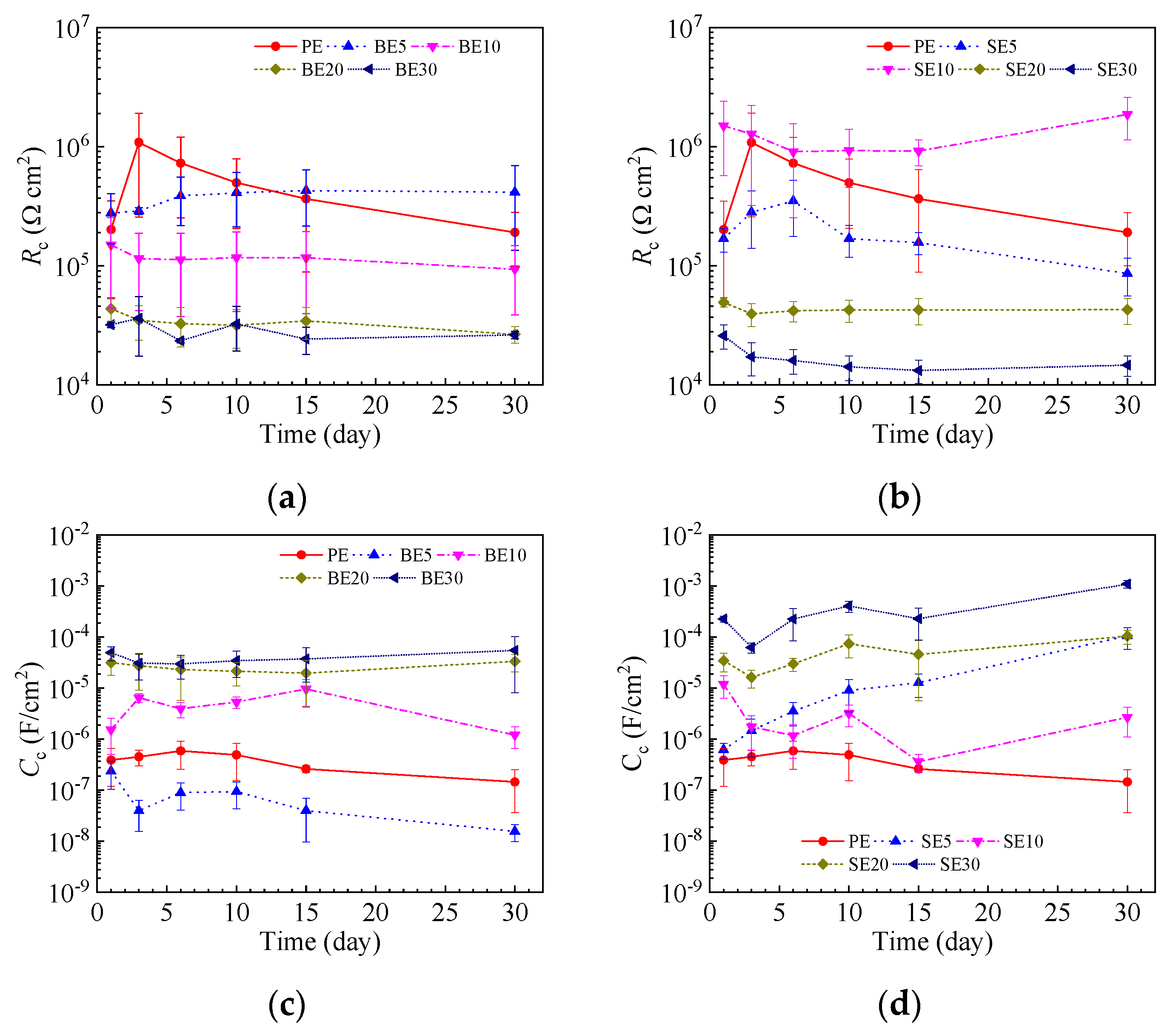
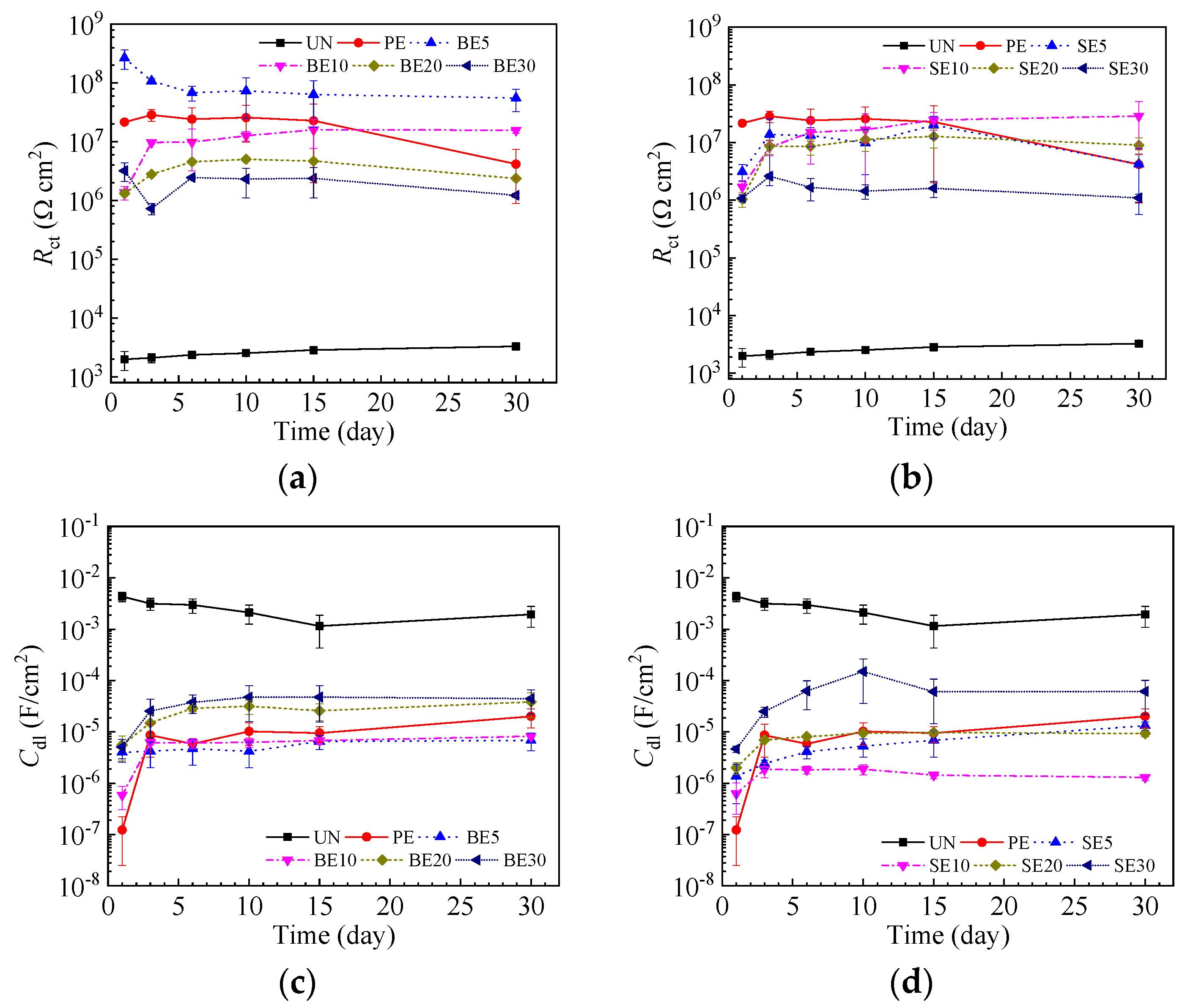
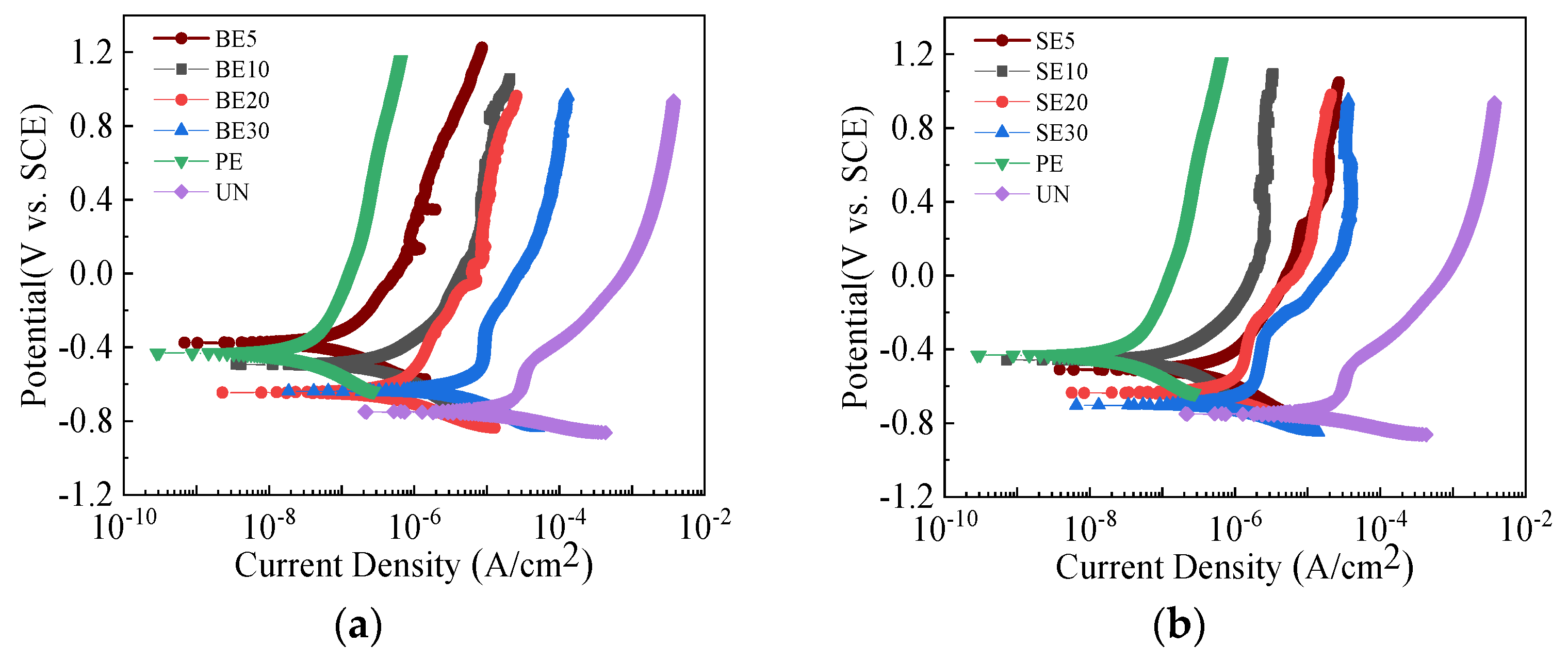
| Element | C | Si | Mn | P | S | Fe |
| wt.% | 0.14 | 0.20 | 0.39 | 0.023 | 0.013 | balance |
| Element | SiO2 | Al2O3 | B2O3 | NaNO3 | CaF2 | K2CO3 | Li2CO3 | TiO2 | CoO | Ni2O | MnO2 | Na2CO3 |
| wt.% | 37.8 | 15.8 | 14.6 | 4.8 | 3.6 | 6.7 | 5.4 | 2.7 | 0.5 | 1.2 | 5.2 | 1.7 |
| Quartz Sand Particle Size | Quartz Sand Content (wt.%) | ||||
|---|---|---|---|---|---|
| 0% | 5% | 10% | 20% | 30% | |
| Big (0.83–1.7 mm) | PE#1 PE#2 PE#3 | BE5#1 BE5#2 BE5#3 | BE10#1 BE10#2 BE10#3 | BE20#1 BE20#2 BE20#3 | BE30#1 BE30#2 BE30#3 |
| Small (0.38–0.83 mm) | SE5#1 SE5#2 SE5#3 | SE10#1 SE10#2 SE10#3 | SE20#1 SE20#2 SE20#3 | SE30#1 SE30#2 SE30#3 | |
| Specimen | UN | PE | BE5 | BE10 | BE20 | BE30 | SE5 | SE10 | SE20 | SE30 |
|---|---|---|---|---|---|---|---|---|---|---|
| Ec (mV/SCE) | −730 ± 13 | −338 ± 8 | −404 ± 20 | −490 ± 18 | −658 ± 56 | −609 ± 29 | −424 ± 11 | −541 ± 12 | −665 ± 15 | −692 ± 18 |
| ic (µA/cm2) | 33.0 ± 5.0 | 0.46 ± 0.21 | 0.22 ± 0.10 | 0.58 ± 0.10 | 0.30 ± 0.09 | 0.79 ± 0.12 | 0.38 ± 0.08 | 0.13 ± 0.01 | 0.12 ± 0.06 | 0.44 ± 0.1 |
Disclaimer/Publisher’s Note: The statements, opinions and data contained in all publications are solely those of the individual author(s) and contributor(s) and not of MDPI and/or the editor(s). MDPI and/or the editor(s) disclaim responsibility for any injury to people or property resulting from any ideas, methods, instructions or products referred to in the content. |
© 2023 by the authors. Licensee MDPI, Basel, Switzerland. This article is an open access article distributed under the terms and conditions of the Creative Commons Attribution (CC BY) license (https://creativecommons.org/licenses/by/4.0/).
Share and Cite
Cui, H.; Tang, F.; Li, B.; Lin, Z. Microstructure and Corrosion Resistance of Quartz Sand-Modified Enamel-Coated Steel Plates. Coatings 2023, 13, 1704. https://doi.org/10.3390/coatings13101704
Cui H, Tang F, Li B, Lin Z. Microstructure and Corrosion Resistance of Quartz Sand-Modified Enamel-Coated Steel Plates. Coatings. 2023; 13(10):1704. https://doi.org/10.3390/coatings13101704
Chicago/Turabian StyleCui, Hao, Fujian Tang, Bo Li, and Zhibin Lin. 2023. "Microstructure and Corrosion Resistance of Quartz Sand-Modified Enamel-Coated Steel Plates" Coatings 13, no. 10: 1704. https://doi.org/10.3390/coatings13101704
APA StyleCui, H., Tang, F., Li, B., & Lin, Z. (2023). Microstructure and Corrosion Resistance of Quartz Sand-Modified Enamel-Coated Steel Plates. Coatings, 13(10), 1704. https://doi.org/10.3390/coatings13101704








